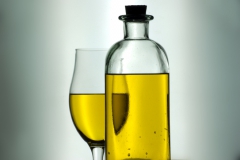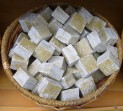Attractions
Greek olive oil

Olive oil is a vegetable oil obtained from olives (Olea europaea) by pressing or other mechanical processes. It is mainly used in the food, cosmetic and pharmaceutical industries. Olive oil is a typical component of Mediterranean cuisine. Consumption of olive oil is considered to be beneficial to health because it contains monounsaturated fatty acids and vitamin E.
95% of all olive trees, and therefore the majority of total olive oil production, come from the Mediterranean region. The three largest producers in the world are Spain, Italy and Greece, with Turkey and Morocco rounding out the top five.
Olive oil in Greece
The olive tree has been growing in Greece for over 10,000 years, according to Homer, who even called olive oil liquid gold. Ancient records mention the use of olive oil for medicinal purposes, body care, cleaning, perfume making and, last but not least, for lighting. Even the famous ancient physician Hippocrates used this 'liquid gold' to treat his patients.
In ancient Greek temples, olive oil was burned in sacred lamps. People believed that olive branches and olive oil had the ability to protect them from evil spirits and prolong their lives. This belief gave rise to the ancient ceremony of anointing kings and high priests with oil. The reverence for olive oil is evidenced by the fact that men who won athletics competitions in Athens were rewarded with a jar of olive oil.
Types of olive oils:
- Extra virgin olive oil: this is the highest quality olive oil, containing less than 0.8% free acidity per 100 g, with the strongest flavour. This top-quality oil accounts for only 10 % of world production. However, it is interesting to note that up to 80 % of all olive oil from Greece is extra virgin.
- Virgin olive oil: is a lower quality version of olive oil than extra virgin oil. It is produced only by mechanical processes without heat or chemical treatment. The advantage over extra virgin olive oil is its lower price. Quality virgin olive oil can be used for both cold and hot cooking. The smoke point of virgin olive oil is somewhere between 207 and 210°C, which means you can safely use it for baking, cooking and frying. The ideal temperature for frying is around 170°C.
- Refined olive oil: Refined oils do not differ from virgin oils in their free acid content (around 0.5%), but mainly in the way they are produced. These oils are obtained by heat treatment (up to 90 °C) and then chemically treated.
Unfortunately, olive oil loses its typical colour, smell and taste through refining. They are usually labelled as Pure olive oil or just Olive oil and are particularly suitable for frying rather than direct consumption. - Olive oil from the cake (Sansa do oliva, Pomace, Matolin olive oil): this is the worst quality olive oil, which is produced by hot pressing. In Greece, this category of olive oil is known as industry oil. It is widely used in the production of olive cosmetics, in medicine or in industry. In order to be consumable and edible, olive oil obtained in this way must be chemically treated by refining. After the production of extra virgin olive oil, there is still quite a lot of olive oil in the pressed residue (olive pomace). The olive scrap is then heated at high temperatures to produce olive oil of the worst quality.
Production of extra virgin olive oil:
It takes 5 to 6 kilograms of olives to produce 1 litre of olive oil. The olives on the olive tree only ripen when they are 10 to 15 years old. After 100 to 150 years, the quantity of olives on the tree gradually begins to decrease, but the age of the olive tree affects only the quantity of olives ripening, not their quality.
The best quality oil is obtained from olives that already contain a sufficient quantity of oil but are not yet perfectly ripe (these ripe fruits are more prone to rot and fallen fruit is also unusable for this type of oil). The most important thing is therefore to estimate the right time for harvesting.
The most ideal method is to pick the fruit by hand directly from the tree - but this is a time-consuming, labour-intensive and therefore financially expensive method. Another factor determining the quality of the oil is its acidity. The olives should be as undamaged as possible, no other matter (twigs, leaves, etc.) should be introduced into the processing and the olives should be processed as soon as possible after harvesting to prevent any mould or fermentation. This is followed by the cleaning stage. Firstly, to remove foreign matter and secondly, in a water bath, for example, to remove dirt, etc. The fruit thus cleaned, including the stone, is ground to a paste as fine as possible, which should not be subject to oxidation. The paste must be mixed with the liquid which has separated during milling. This process is carried out by stirring at a temperature of around 25 °C.
The whole mass is then subjected to centrifugation, which separates the solids from the liquid. The final step is the separation of the oil from the water and the subsequent bottling of the pure oil into stainless steel tanks, where the oil is stored at a temperature of around 15 °C without access to air. Since olive oil oxidises in the light, it must be sold and stored in dark bottles.
Acidity
The acidity of olive oil means the quality of the fruit and the flawlessness of the processing. If the olives are damaged during harvesting, they undergo a chemical reaction that produces free fatty acids. This is the same process that occurs when olives are overripe (producers press more oil from overripe olives). Long-term storage of olives also causes this undesirable process. In simple terms, olive oils with higher acidity can be made from rotten or otherwise poor quality olives. For the above reason, it is important that olive oil is produced with extreme care and attention. This is the only way to produce quality olive oil.
How to choose a good olive oil
- For quality oils, the label should indicate the acidity value of the olive oil. The lower the acidity value, the higher the quality of the olive oil. Commonly available extra virgin oils have an acidity value of around 0,8 %. Quality oils have an acidity value of around 0,5 %. Top quality oils have an acidity value of around 0.3% or less. The lower the acidity value, the less we feel an unpleasant burning sensation in the throat area after swallowing the oil. Information about the country or region of origin, the type of olive tree and the way the olives are harvested and processed is also important. The climate also has a considerable influence on the quality of the olives. Along with the acidity, information on the peroxide value, wax content and K 270 must be given.
- Quality olive oils can be packaged in both glass and tin. Producers often supply quality oil in tin packaging because they are then able to offer a higher quality oil at a lower price. Tin packaging does not harm the olive oil. On the contrary, the tin provides better protection from light, which is very harmful to all oils. If glass packaging is used, it must be dark in colour so that the light cannot penetrate the oil.
- The price of quality olive oil should be about 300 CZK per litre. The low price raises doubts about the quality. The reason for the lower price of the oil may be, for example, an unstated acidity value, missing quality certificates or information on the country of origin. Quality olive oil always has a clear indication of the region of origin and the type of olives or types of olives from which it has been produced. The region of origin plays a decisive role in quality.
Extra virgin olive oil and health:
- contains vitamins A, E, D, K
- contains calcium, potassium, iron, phosphorus and magnesium
- has a high content of antioxidants, which are substances that eliminate free radicals
- benefits from its chlorophyll content
- it is rich in essential fatty acids, essential for the proper functioning of the body
- is used to reduce the proportion of bad LDL cholesterol and increase the proportion of good HDL cholesterol in the blood
- regulates digestion and helps with constipation
- supports digestion and intestinal microflora
- reduces the risk of heart attacks and strokes
- helps heal tibial ulcers, eczema, wounds, burns, scars and other skin defects
- used in detoxification of the body
- gargling when warm helps with colds, dissolves phlegm very well
- has a positive effect on muscle massages after sports, bruises or sprains
- in combination with herbs, it is used for many ailments
- helps with weight reduction diets
- promotes bone growth in young children
- counteracts the development of cancer
- slows down ageing (already at the cellular level)
- promotes blood circulation and lowers blood pressure
- softens and softens the skin
- protects the skin against frost
- accelerates scar healing
- suppresses some inflammatory skin conditions such as psoriasis and acne
- it has an effect against cracked skin
- it is recommended to apply olive oil after sunbathing
Interestingly, however, if you want to improve your immunity, gums and teeth, contribute to the overall detoxification of your body, or get better breath in the morning, you don't actually have to eat olive oil. One of the traditional practices that work like a small miracle is the daily "bark", in which you take a sip of olive oil in your mouth (you need to spit out the saliva thoroughly beforehand) and hold the liquid in your mouth, occasionally rolling it around with your cheeks and tongue, for about fifteen to twenty minutes before spitting it out. This seems like a lot of time, but considering that it is not a problem to take a shower, clean the kitchen or make the children's lunch for school during this time, it is not that much. Olive oil not only absorbs the toxins that have "leached" into the oral cavity during the night, but it also nourishes our entire body. Smokers praise the fact that the obligatory morning cough disappears with long-term practice with olive oil, and those who suffer from periodontitis notice a significant improvement.
Longevity in Crete
A number of medical studies confirm that the longest living people in Europe are Cretans. They live to an enviably old age, even though they smoke more than is customary in Western Europe, and are sometimes closer to a glass of ouzo than is healthy. And so the classic Cretan diet, which the islanders have been eating unchanged for a couple of thousand years, is becoming a worldwide fashion.
Greek cuisine is very tasty and healthy, and Cretan cuisine is considered the healthiest in the Mediterranean. The basis of the Cretan diet is bread, white goat's or sheep's cheese 'feta' (the most similar to Balkan cheese), vegetables, olives, fruit and above all olive oil, which is the most important ingredient. You can find it in large doses in almost any dish. The Greeks are true champions in its consumption, ranking first in the world. Cretans have an incredibly high consumption of olive oil. Twenty-five litres of olive oil are consumed annually per capita.
Olive oil is also used in Crete to treat skin diseases. The Cretans themselves claim that olive oil helps with everything from childhood colic to old age debility.
Olive oil is simply that miraculous Cretan elixir of life. Extra virgin olive oil is increasingly recommended as part of a healthy and balanced diet.




